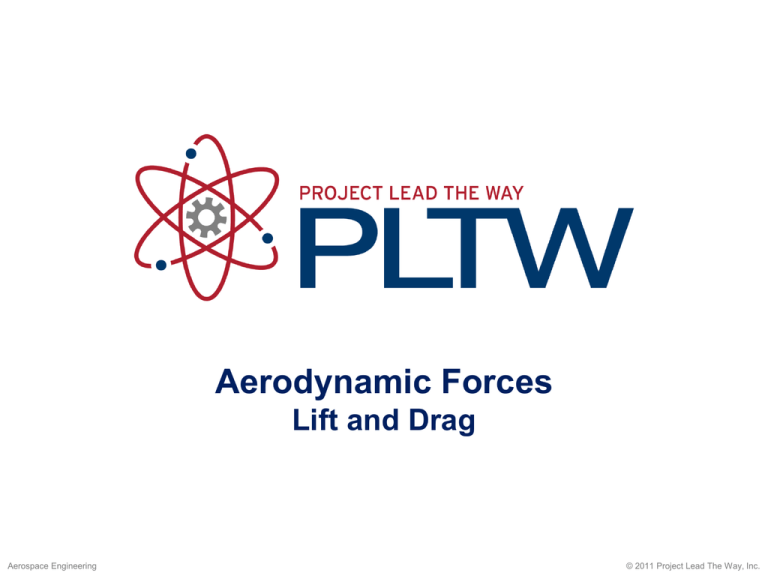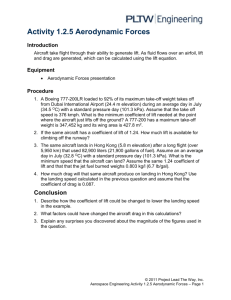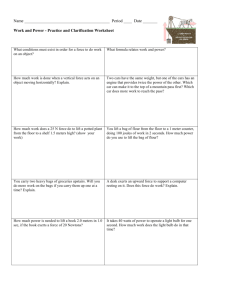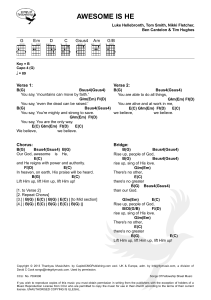Aerodynamic Forces
advertisement

Aerodynamic Forces Lift and Drag Aerospace Engineering © 2011 Project Lead The Way, Inc. Lift Equation Lift Coefficient of Lift, Cl – Determined experimentally – Combines several factors • Shape • Angle of attack 2𝐿 𝐶𝑙 = 𝐴𝜌𝑣 2 Alternate format 𝐿 𝐶𝑙 = 𝑞𝐴 Direction of Flight 𝐶𝑙 = 𝐶𝑜𝑒𝑓𝑓𝑖𝑐𝑖𝑒𝑛𝑡 𝑜𝑓 𝐿𝑖𝑓𝑡 𝐷 = 𝐷𝑟𝑎𝑔 𝑁 𝐴 = 𝑊𝑖𝑛𝑔 𝐴𝑟𝑒𝑎 𝑚2 𝑘𝑔 𝜌 = 𝐷𝑒𝑛𝑠𝑖𝑡𝑦 𝑚3 𝑚 𝑣 = 𝑉𝑒𝑙𝑜𝑐𝑖𝑡𝑦 𝑠 𝑞 = 𝐷𝑦𝑛𝑎𝑚𝑖𝑐 𝑃𝑟𝑒𝑠𝑠𝑢𝑟𝑒 𝑃𝑎 Applying the Lift Equation The Cessna 172 from Activity 1.2.2 step #2 takes off successfully from Denver, CO during an average day in May (22 OC) with a standard pressure (101.3 kPa). Assume that the take-off speed is 55 knots (102 kph). What is the minimum coefficient of lift needed at the point where the aircraft just lifts off the ground? The Cessna wing area is 18.2 m2 and weight is 2,328 lb (1,056 kg). Applying the Lift Equation Convert mass into weight 𝑤 = 𝑚𝑔 𝑚 𝑤 = (1,056 𝑘𝑔) 9.81 2 𝑠 𝑤 = 10,359 𝑁 Convert velocity 𝑚 102 𝑘𝑝ℎ 1000 𝑘𝑚 𝑉= 𝑚𝑖𝑛 𝑠 60 60 𝑚𝑖𝑛 ℎ𝑟 𝑚 𝑉 = 28.3 𝑠 Applying the Lift Equation Calculate Air Density 𝜌= 0.2869 𝐽 𝑘𝑔 𝐾 𝑝 𝐾 𝑇 + 273.1℃ ℃ 101.29 𝑘𝑃𝑎 𝜌= 0.2869 𝐽 𝑘𝑔 𝐾 𝑘𝑔 𝜌 = 1.196 3 𝑚 𝐾 22 ℃ + 273.1℃ ℃ Applying the Lift Equation Calculate coefficient of lift assuming that lift equals weight 2𝐿 𝐶𝑙 = 𝐴𝜌𝑣 2 𝐶𝑙 = 18.2 𝑚2 𝐶𝑙 = 1.19 2(10,359 𝑁) 𝑘𝑔 𝑚 1.196 3 28.3 𝑠 𝑚 2 Boundary Layer • Fluid molecules stick to object’s surface • Creates boundary layer of slower moving fluid • Boundary layer is crucial to wing performance Boundary Layer and Lift • Airflow over object is slower close to object surface • Air flow remains smooth until critical airflow velocity • Airflow close to object becomes turbulent Reynolds Number, Re • Representative value to compare different fluid flow systems • Object moving through fluid disturbs molecules • Motion generates aerodynamic forces Airfoil1 Comparable to Airfoil2 when Re1 = Re2 Angle of Attack (AOA) Affects Lift Lift increases with AOA up to stall angle Airflow Lift Lift Airflow Direction of Flight Lift Stall Direction of Flight Angle of Attack Reynolds Number • Ratio of inertial (resistant to change) forces to viscous (sticky) forces • Dimensionless number 𝜇 v𝑙 𝜌v𝑙 ν= 𝑅𝑒 = 𝑅𝑒 = or 𝜌 ν 𝜇 𝑙 = 𝐿𝑒𝑛𝑔𝑡ℎ 𝑜𝑓 𝑅𝑒 = 𝑅𝑒𝑦𝑛𝑜𝑙𝑑𝑠 𝑁𝑢𝑚𝑏𝑒𝑟 𝐹𝑙𝑢𝑖𝑑 𝑇𝑟𝑎𝑣𝑒𝑙 𝑚 𝑘𝑔 𝑁𝑠 𝜌 = 𝐹𝑙𝑢𝑖𝑑 𝐷𝑒𝑛𝑠𝑖𝑡𝑦 𝜇 = 𝐹𝑙𝑢𝑖𝑑 𝑉𝑖𝑠𝑐𝑜𝑠𝑖𝑡𝑦 𝑚3 𝑚2 𝑚 2 v = 𝑉𝑒𝑙𝑜𝑐𝑖𝑡𝑦 𝑚 𝑠 ν = 𝐾𝑖𝑛𝑒𝑚𝑎𝑡𝑖𝑐 𝑉𝑖𝑠𝑐𝑜𝑠𝑖𝑡𝑦 𝑠 Applying Reynolds Number A P-3 Orion is cruising at 820 kph (509 mph) at an altitude of 4,023 m (13,198 ft). Assume a fluid viscosity coefficient of 1.65x10-5 N(s)/m3. What is the average Reynolds Number along a wing cross section measuring 1.1 m (3.6 ft) from leading edge to trailing edge? Need components to calculate Re 𝜌v𝑙 𝑅𝑒 = 𝜇 Applying Reynolds Number Calculate Air Temperature ℃ 𝑇 = 15.04℃ − 0.00649 ℎ 𝑚 ℃ 𝑇 = 15.04℃ − 0.00649 (4,023 𝑚) 𝑚 𝑇 = −11.1℃ Calculate Air Pressure 𝑝 = 101.29𝑘𝑃𝑎 𝑝 = 61.5 𝑘𝑃𝑎 𝐾 −11.1℃ + 273.1℃ ℃ 288.08 𝐾 5.256 Applying Reynolds Number Calculate Air Density 𝑝 𝜌= 0.2869 𝐽 𝑘𝑔 𝐾 𝑇 + 273.1 61. 5 𝑘𝑃𝑎 𝜌= 0.2869 𝐽 𝑘𝑔 𝐾 𝑘𝑔 𝜌 = 0.818 3 𝑚 𝐾 −11.1 ℃ + 273.1 ℃ Applying Reynolds Number Convert Velocity 𝑚 820 𝑘𝑝ℎ 1000 𝑘𝑚 𝑉= 𝑚𝑖𝑛 𝑠 60 60 𝑚𝑖𝑛 ℎ𝑟 𝑚 𝑉 = 227.8 𝑠 Applying Reynolds Number Calculate Re 𝜌v𝑙 𝑅𝑒 = 𝜇 𝑘𝑔 𝑚 0.817 3 227.8 (1.1 𝑚) 𝑠 𝑚 𝑅𝑒 = 𝑁𝑠 −5 1.65 × 10 𝑚2 𝑅𝑒 = 12,408,000 Drag Equation Drag Coefficient of drag, Cd – Determined experimentally – Combines several factors • Shape • Angle of attack 2×𝐷 𝐶𝑑 = 𝐴 × 𝜌 × 𝑣2 Alternate format 𝐷 𝐶𝑑 = 𝑞 ×𝐴 Direction of Flight 𝐶𝑑 = 𝐶𝑜𝑒𝑓𝑓𝑖𝑐𝑖𝑒𝑛𝑡 𝑜𝑓 𝐷𝑟𝑎𝑔 𝐷 = 𝐷𝑟𝑎𝑔 𝑁 𝐴 = 𝑊𝑖𝑛𝑔 𝐴𝑟𝑒𝑎 𝑚2 𝑘𝑔 𝜌 = 𝐷𝑒𝑛𝑠𝑖𝑡𝑦 𝑚3 𝑚 𝑣 = 𝑉𝑒𝑙𝑜𝑐𝑖𝑡𝑦 𝑠 𝑞 = 𝐷𝑦𝑛𝑎𝑚𝑖𝑐 𝑃𝑟𝑒𝑠𝑠𝑢𝑟𝑒 𝑃𝑎 Coefficient of Drag (Cd) Object shape affects Cd Applying the Drag Equation The same Cessna 172 from Activity 1.2.2 step #2 takes off under the same conditions as described earlier in this presentation. How much drag is produced when the wing is configured such that the coefficient of drag is 0.05? Applying the Drag Equation Calculate drag 2𝐷 𝐶𝑑 = 𝐴𝜌𝑣 2 𝐶𝑑 𝐴𝜌𝑣 2 𝐷= 2 0.05 18.2 𝑚2 𝐷= 𝐷 = 436 𝑁 𝑘𝑔 1.196 3 𝑚 2 𝑚 28.3 𝑠 2 Downwash and Wingtip Vortices • Pressure difference at wing tips • Air to spill over wingtip perpendicular to main airflow • Air flows both upward and rearward, forming a vortex • Decreases lift • Increases drag Wingtip Vortices • Air flows both upward and rearward, forming a vortex • Winglets are vertical airfoils that limit vortices and improve fuel efficiency Reference National Aeronautics and Space Administration (2011). Aerodynamic forces. Retrieved from http://www.grc.nasa.gov/WWW/K12/airplane/presar.html National Aeronautics and Space Administration (2011). Reynolds number. Retrieved from http://www.grc.nasa.gov/WWW/BGH/reynolds.html National Aeronautics and Space Administration (2011). Winglets. Retrieved from http://www.nasa.gov/centers/dryden/about/Organizations/Technolog y/Facts/TF-2004-15-DFRC.html Raymer, P. (2006). Aircraft design: A conceptual approach. Reston, VA: American Institute of Aeronautics and Astronautics.






